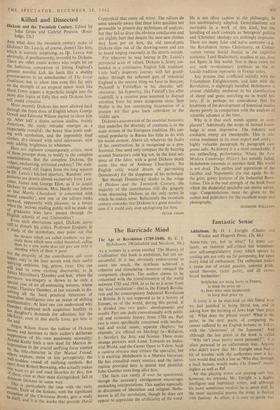Killed and Dissected
Dickens and the Twentieth Century. Edited by John Gross and Gabriel Pearson. (Rout- - ledge, 32s.) AND what does the twentieth century make of Dickens? Dr. Leavis, of course, doesn't like him, Which is scarcely surprising, as pr. Leavis was obviously, if posthumously, inventtd by Dickens. There are other comic writers who might hit on the ludicrous conception of letting England's greatest novelist kick his heels like a shabby process-server in an antechamber of The Great Tradition; but to allow him even this far only on the strength of an atypical minor work like Hard Times argues a hyperbolic insight into the more dire logics of folly that only Dickens him- self could conceive. More recently Dickens has been allowed back through the front door of English letters. George Orwell and Edmund Wilson started to clean him Up. After half a dozen serious studies, mainly American, the seedy intruder emerges as a respectable moralist: the heavy blue jowls reek- ing with symbolism, and the impossibly loud Clothes, dry-cleaned with total relevances, now only adding brightness to whiteness. Here are eighteen contemporary critics, most of them younger dons, to testify to the complete rehabilitation. But the complete Dickens, the vulgar, enchanting, universal cockney? The stale- cabbage smell still lingers from the long sojourn in Dr. Leavis's kitchen quarters. 'Random' com- parisons are drawn almost exclusively from Law- rence, James' and George Eliot, as if to acquit Dickens by association; Mrs. Hardy can inform US that Martin Chuzzlewit 'is concerned with moral causality'; and one of the editors looks forward, apparently with pleasure, to a future When the 'serious reading public will be made up of graduates who have passed through the English schools of our Universities'! Even such aberrations apart, Dickens seems Still to disturb his critics. Professor Empson, in a study of the symbolism, may point out that the devices which are called symbolic are pre- cisely those which were called theatrical; calling them by a new name does not give any help in deciding which of them is good,
but the majority of the contributors still seem happy only in the later novels with their useful unifying
emblems, fog, prison, river. This can still lead to some exciting discoveries, as in Julian Moynihan's 'Dombey and Son,' where the Pervasive sea-imagery is shown to be only a special case of an all-embracing wetness, whose avatar, Florence Dombey, at last succeeds in dis- 8,°1ving all the hard practical structures of masculine intelligence into an ocean of shifting -ent`Tentality. At least one can understand why Dombey displayed such suspicious hostility to
daughter's demands for affection; but the nre- c furc..,
the end. even in this sterile form, got him in Angus heroes Wilson traces the tedium of Dickens and heroines to their author's deliberate sAuPPression of his own passionate sensuality; rnc.id Kettle finds a new slant for Marxist in- terpretation in the crucial unifying force exerted y the title-character in Our Mutual Friend; On _thers explore, more or less perceptively, the „well-trodden round of unifying symbols. But apart from Robert Browning, who actually makes "nfe want to go and read Sketches by Boz, few o t?teln, even at their most distinguished, fail to mitrunish Dickens in some way. nov !Ils i! is particularly the case with the early Each of the fictions, with the significant exeeption of the Christmas Books, gets a study t45 itself, and it is the works that precede David
Copperfield that come off worst. The editors do seem uneasily aware that these have qualities not permeable to present-day techniques of analysis; but they fail to draw the obvious conclusions and are slightly hurt that despite the neat new clothes they have put on him, the old apocalyptic Dickens slips out of the drawing-room and can be heard singing raucously in the streets outside.
For wherever he may belong in Dr. Leavis's provincial scale of values, Dickens is firmly em- bedded in a continuous English folk tradition. Little Nell's desperate journey with her grand- father through the inflamed guts of industrial England is the nearest thing we have to Bunyan; Pecksniff is Falstaffian in his cherubic self- obsession : his hypocrisy, like Falstaff's lies after Gadshill, is a creative pose assumed to distract attention from his more dangerous vices; am Weller is the last convincing incarnation of a' peasant wit that goes back unbroken to the middle ages.
Dickens's asseveration of the essential humanity that underlies the diversity of creatures is in the main stream of the European tradition. His uni- versal popularity in Russia has little to do with his social content. Above all, whatever the faults of his construction, he is recognised as a pro- fessional. One need only compare the fly buzzing around Nastasya's cold big toe, in the final set- piece of The Idiot, with a good Dickens death scene like that of Anthony Chuzzlewit. No English critic would dream of patronising Dostoievsky for the sloppiness of his technique. But though Dostoievsky skulks in the wings of Dickens and the Twentieth Century, the majority of the contributors still shy gingerly from discussing Dickens in the only terms in which he makes sense. Reluctantly the twentieth century concedes that Dickens is a great novelist : now if it could only stop apologising for him.
PETER ['ISDN






























 Previous page
Previous page